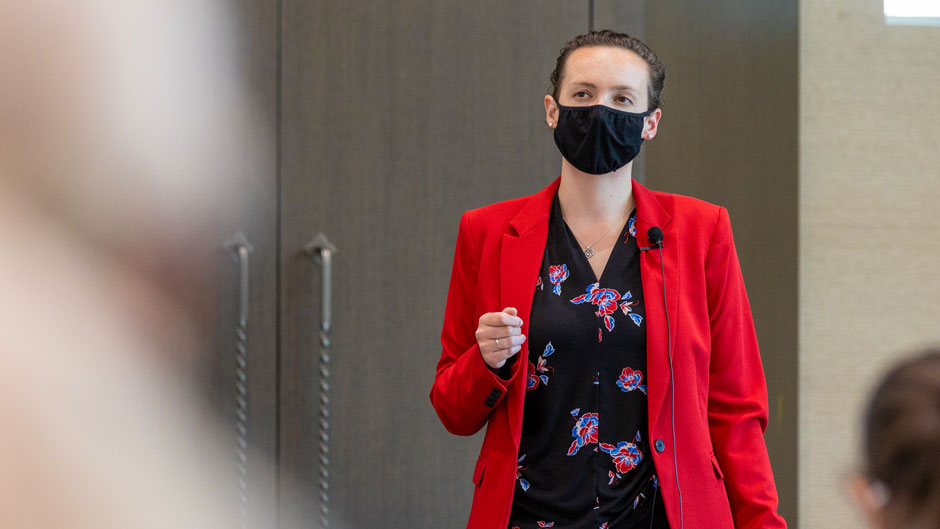Christine Pardo, a Ph.D. candidate from the University of Miami Abess Center for Ecosystem Science and Policy shared her research about the beautiful, yet destructive invasive species of Zingiber spectabile (or the Maraca plant) taking over the rainforests of central Costa Rica.
Meanwhile, David McMillan, a postdoctoral associate at the Miller School of Medicine, shared that he wants to investigate whether scuba diving can help people with spinal cord and traumatic brain injuries ease their pain and improve mobility.
And master’s student Marina McLerran described her survey of music educators across the nation, which revealed that up to 80 percent of respondents have taught students who are deaf or experience severe hearing loss to play an instrument without any formal training in the practice. Armed with her research, McLerran now wants to craft evidence-based training for these teachers, since she was one of them.
“As music educators, we teach the manipulation of sound, yet there are no standard courses on hearing loss,” said McLerran, who worked as a band director in Texas. “There is a population of music educators that need this information, so it will be a goal of mine to develop flexible and tangible resources for educators working with these students.”
The three researchers were among nearly 70 ambitious graduate students and postdoctoral fellows who shared their work with the University community Friday afternoon at the third annual Graduate and Postdoctoral Research Symposium. The conference was hosted virtually this year, and the poster sessions illustrating student and postdoctoral research were displayed in virtual breakout rooms throughout the afternoon.
“This was an opportunity to showcase our very talented graduate students and postdocs and their research,” said Guillermo “Willy” Prado, dean of the Graduate School and vice provost of faculty affairs. “I hope that everyone who attended learned something new this year. I sure did.”
Jumpstarting the symposium, Erin Kobetz, vice provost for research and scholarship, described some of the breakthroughs she has had, and lessons she’s learned as an epidemiologist and cancer disparities researcher during her 17 years at the University. Kobetz joined the Miller School faculty shortly after earning her Ph.D. from the University of North Carolina, and said she was thrilled at the opportunity but also naïve about how quickly she would be able to advance in her field at the Sylvester Comprehensive Cancer Center.
Still, Kobetz trusted her instincts, and after uncovering data that showed women in Miami’s Little Haiti neighborhood had cervical cancer rates four times higher than the national average, she spent months brainstorming with local community health workers about how to combat the disturbing trends. Her success in forging partnerships with community organizations helped pave the way for Haitian women to be tested and treated for this cancer in more culturally responsive ways, which Kobetz said she only learned by working with health care providers in the region.
The value of teamwork both at the University and in the community was also highlighted in future years, as Kobetz worked with firefighters to learn why so many of them were dying from cancer. With public health associate professor Alberto Caban-Martinez and a group of University faculty on the Sylvester Comprehensive Cancer Center’s Firefighter Cancer Initiative, Kobetz said they discovered that firefighters were exposing themselves to carcinogens repeatedly by keeping on their gear and often cleaning it themselves after a fire was over. Today, “Decon” kits help firefighters across Florida contain the contaminants and lower their exposure to the dangerous inhalants.
These two experiences underscored the purpose for her work, Kobetz said, which was to improve access to health care for all populations in South Florida. Despite the inevitable challenges, Kobetz urged graduate students to always remember the “why,” or calling, that brought them to their chosen field.
“The reason I got into public health, and the reason I remain passionate about it, is I see my research as a vehicle for social justice and as a way to advance health equity,” she said. “So, I stay true to my why.”
After Kobetz spoke, two TED-talk-style presentations were given. One by McLerran, as well as one by public health graduate student Cho-Hee Shrader, whose project delves into why Miami-Dade County remains a hotbed for HIV transmission, despite the treatments available. In particular, Shrader is studying how the social network theory of homophily—or the idea that people are attracted to other people who share a similar trait or attribute with them—may help them to disseminate information about PrEP, short for pre-exposure prophylaxis, to Latino gay men who are most at risk for contracting the virus locally.
In between the lectures, dozens of students offered poster presentations on topics as varied as an architectural analysis of the chawls (tenement-like buildings) of Mumbai, India, and how gentrification may affect them, to immigrants’ choices of where to live in the United States and whether the decision is affected by their level of skills.
To learn more about the Graduate and Postdoctoral Research Symposium and its speakers, visit the event page.

